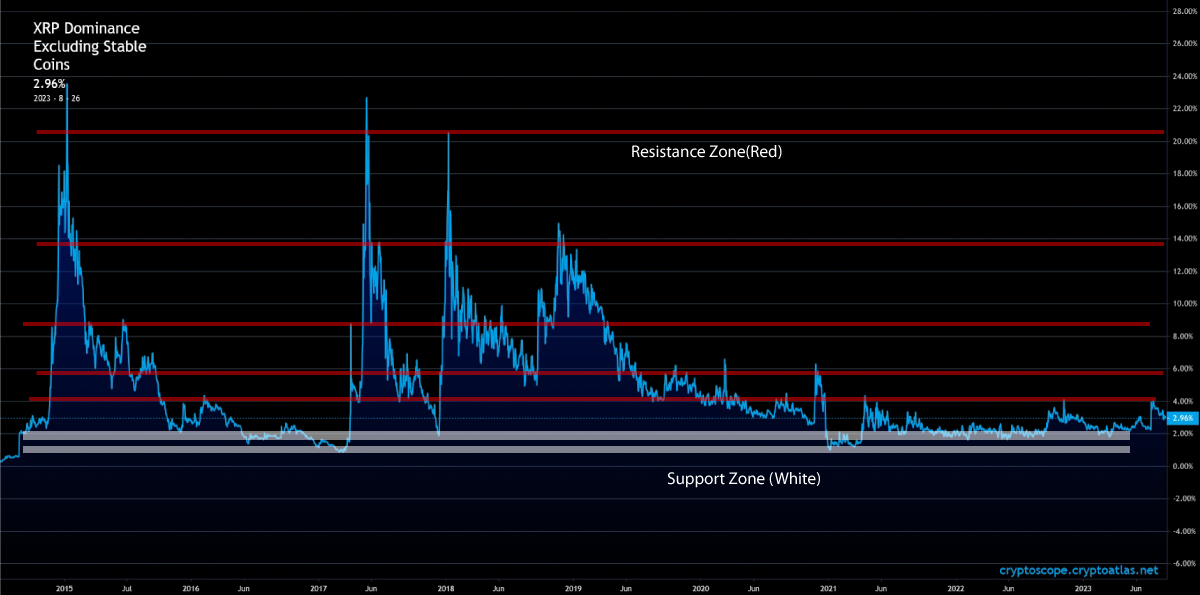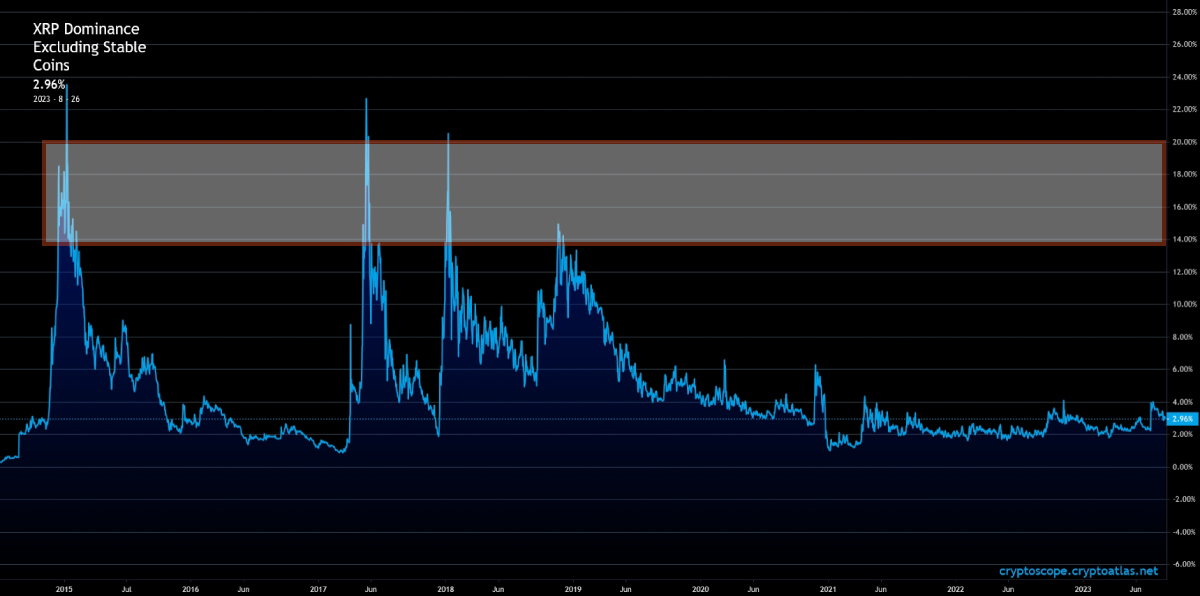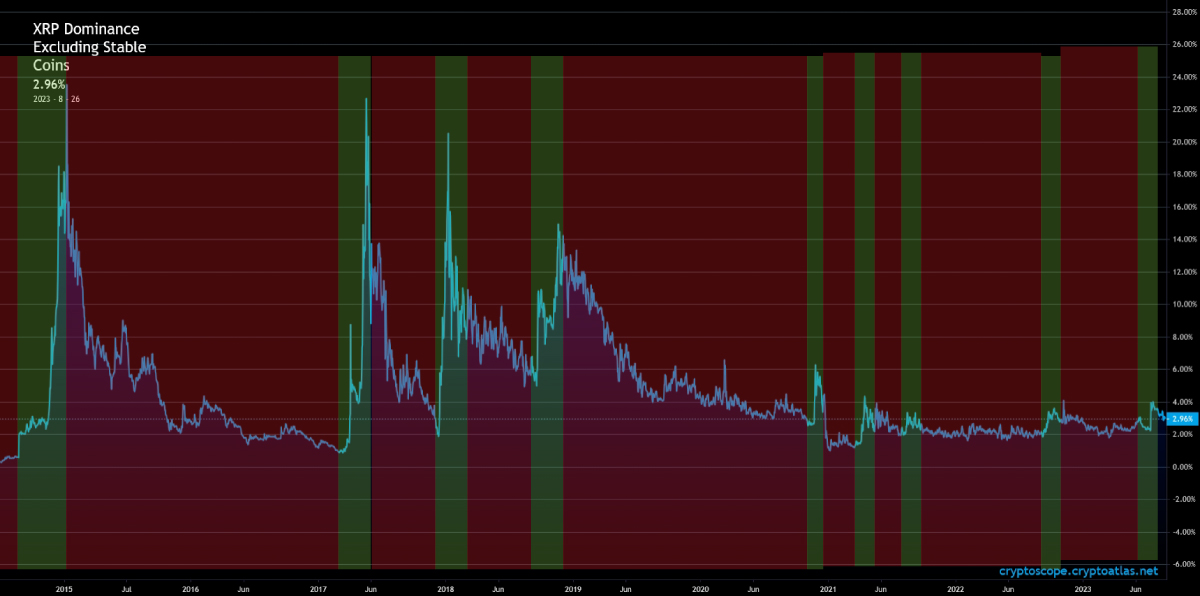Strategies for Trading Based on XRP Dominance Metrics
There are some ways to incorporate the XRP dominance chart into trading analysis and as an indicator.
Let’s start with the basics. The XRP dominance chart goes up and down based on certain market conditions which we covered earlier. When the XRP dominance goes up, it illustrates to us that XRP is outperforming the rest of the cryptocurrencies, with maybe some exceptions. When the XRP dominance goes down, it means that the rest of the cryptocurrency market is outperforming XRP.
This is not synonymous with XRP appreciating in value. XRP can go up in value and go up in dominance. XRP can go up in value and go down in dominance. In this scenario, while XRP goes up in value, the majority of cryptocurrencies also go up in value, just at higher percentages. XRP can go down in value, and the XRP dominance can go up. XRP can also go down in value, and its dominance can also go down.
What happens in these two scenarios? If XRP goes down in value and XRP dominance goes up, it means that the rest of the cryptocurrency market is also going down just at higher rates. XRP is retaining its value better than the rest of the cryptocurrencies. If XRP goes down in value, and the XRP dominance goes down, it means that the rest of the market is crashing, and XRP is crashing in higher percentages. In other words, XRP is losing value faster than the rest of the market.
To make money or retain wealth with XRP, traders and speculators could use the XRP Dominance in 3 ways: To out compete the market during bull runs, and to exit at the opportune time. Or to accumulate XRP at the opportune time, understanding that there is a risk that the value of the XRP might drop.
It is also important to use the XRP dominance as an indicator in combination with other indicators such as the BTC:USD price chart, etc.
Support and Resistance Trading With the XRP Dominance Chart
The XRP Dominance chart respects support and resistance to some degree. Traders and speculators can use the support and resistance to calculate when it is the right moment to get out of their position.
For example, if the XRP dominance is facing significant resistance, and the goal is to accumulate more XRP, the speculator can do two things: sell their XRP for BTC or for stable coins, create a stop loss.
If it goes well and the XRP dominance goes back down, they enter their position again. Whether they make money in fiat or not is irrelevant to this strategy since the goal is to attain more XRP.
If the market is in the first phase of the bull market (it is in accumulation), then it might be a good idea to use the XRP dominance to accumulate more XRP by trading it with BTC. This is in the hopes that the XRP dominance goes way up at the peak of the bull market (which it has twice).
Let’s look at the chart to see some zones of support and resistance.

Understanding when it is a Bad Idea to Hold XRP with the XRP Dominance Chart
There are certain moments or points in time when it is terrible to hold XRP. To understand this, it is first important to understand that Bitcoin moves the market. It is important to accept the fact that Bitcoin is not going to go anywhere, XRP is not going to replace BTC anytime soon.
The fact of the matter is that XRP follows what Bitcoin does, if bitcoin goes up, XRP goes up. When bitcoin goes down, XRP goes down. During the absolute top of bull markets, the risk of holding XRP becomes greater because it means that the bear market is also near.
XRP underperforms BTC and Stable coins in bear markets to such large degrees, that holding XRP during a bear market is not a great idea. XRP will not retain its value well through bear markets, at least not as well as Bitcoin.
Let’s take a look at moments when it is important to get rid of XRP. In the previous bull run, XRP went up many times in terms of dominance.

